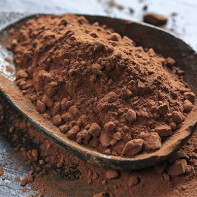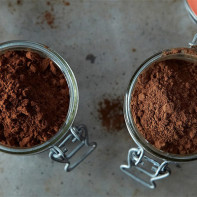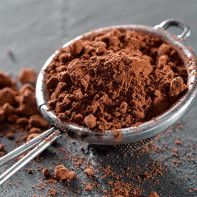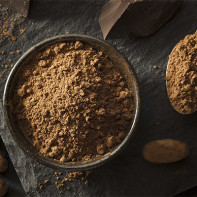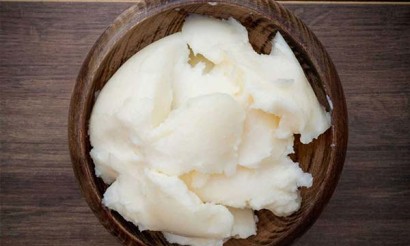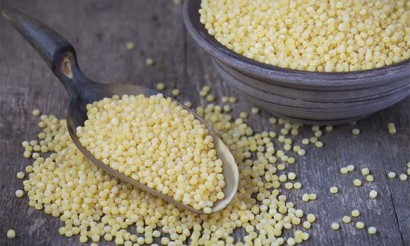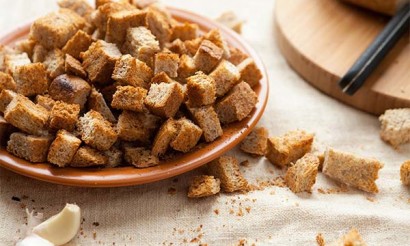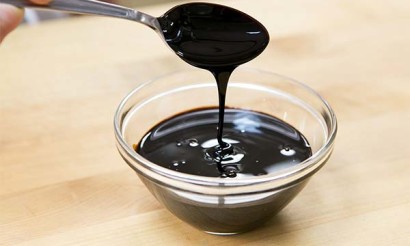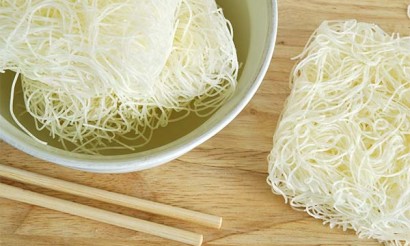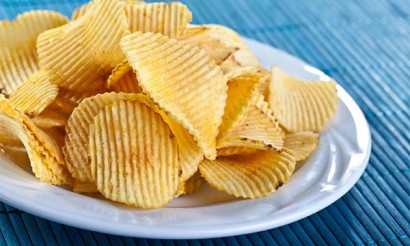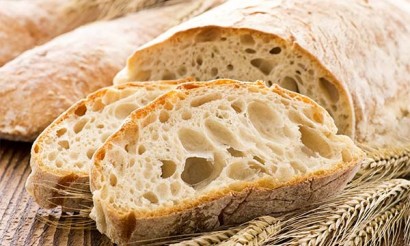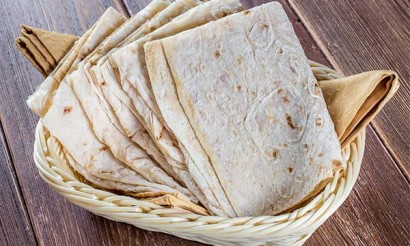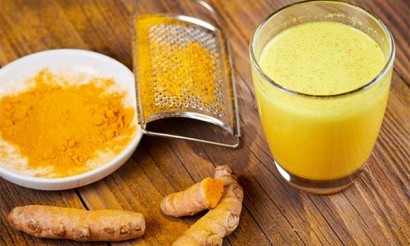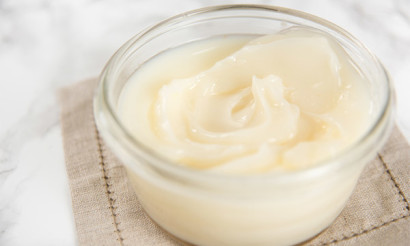Cocoa powder: useful properties and contraindications
Cocoa powder drink, as a rule, evokes pleasant memories of the time when we were all still children. Cocoa powder is a powdery paste obtained from the fruit of the chocolate (cacao) tree due to the prior drying and grinding of the beans.
- What is cocoa powder
- Types of
- Is there caffeine
- Composition and Calories
- What is cocoa powder good for you
- General benefits
- For Women
- For men
- For Pregnancy
- For breastfeeding
- For children
- The benefits of cocoa powder for weight loss
- Therapeutic properties of cocoa powder
- Cocoa powder in cosmetology
- Cocoa Powder Face Masks
- Masks for hair
- Cocoa powder in cooking
- How to make chocolate from cocoa powder
- How to Make Cocoa Powder with Milk
- How to make chocolate frosting from cocoa powder
- Cocoa Powdered Chocolate Cake Cream
- What to substitute for cocoa powder in baked goods
- Hazards and contraindications
- How to choose and store the cocoa powder
- How often you can drink cocoa powder
- Interesting facts about cocoa
In fact, the history of this product is quite interesting. As is known, chocolate powder migrated to the European continent with the seafarer Christopher Columbus. The Aztecs, the tribes that inhabited the Americas, were already growing cocoa trees at that time. They used the fruit they grew to prepare a variety of dishes. The cacao bean drink was very popular because it gave energy, strength, and vigor. The Aztecs were already making a special product that was very similar to the chocolate we know today. The name "chocolate", as it turns out, comes from the word "chocolatl", a product that was produced by the natives.
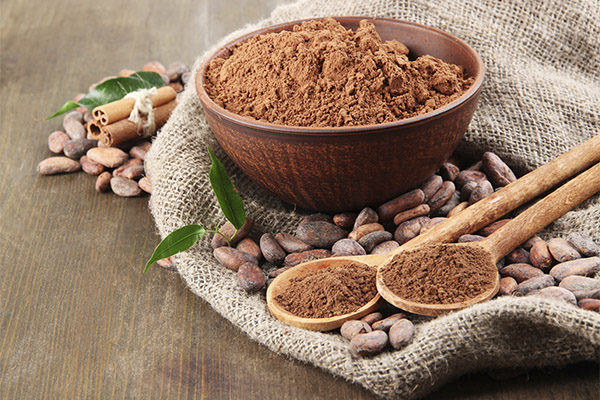
European colonizers adopted the traditional food preferences of the ancient tribes and began to create their own recipes of "chocolatl". It is worth noting that the Swiss, British, and French were the most successful.
The technology of making cocoa powder has not changed much since it was discovered. Only the processing equipment used has changed. In some parts of America, the fruit is still harvested by hand, but the quality of the product is not affected. Sequence of the process:
- The first step is to pick the ripe fruit. A well-sharpened knife is usually used for this procedure (because it is necessary not to touch and preserve the inflorescences, as well as fruits that are not yet ripe).
- Then the fruits should be opened and the seeds should be extracted from them (the fermentation process begins).
- The seeds should be placed in a basket or box, with banana leaves and burlap on the bottom. During this procedure, the temperature of the mass rises to 45-50°C, at which time the germs begin to die. The tartness disappears, but a chocolatey smell and taste emerges.
- The contents of the baskets should be scattered on a flat surface, so that the fruits hit the sunlight, this is necessary for drying. Afterwards the process of polishing takes place (an interesting fact is that in the home country of the cocoa bean the fruit is still polished with the feet during the "cocoa dance").
- After the necessary procedures have been performed, we have to sort out the poor quality fruit. The beans are usually milled, then the oil is extracted from the powder. The remaining powdered mass is used to make chocolate products, drinks, etc.
What is cocoa powder
Cocoa powder is a product obtained by drying and grinding cocoa cake left over from grated and squeezed fruits. The powder is used to make a variety of drinks, including hot chocolate and cocoa with milk. After the cake base has cooled, it is ground to a powdery consistency. The powder has a brownish-reddish color and chocolate flavor.
Types of
The processing of cocoa tree fruit results in several types of powder. They are distinguished by the quality of processing, refinement, and the area in which they were grown. Cocoa powder can be divided into industrial (grown with fertilizers), organic (an environmentally friendly product processed with industrial methods), and live (obtained by hand-processing).
In fact, today there is a large variety of cocoa products on store shelves, so it is not easy to decide what to choose. This is quite interesting, because cocoa is obtained using the same substance, with slight differences in processing techniques. The product can be divided into two types:
- cocoa powder (brewed to make a drink);
- Cocoa drink (prepared by simply diluting the product in boiling water or milk).
It is necessary to know that there is a product that can be called natural (it contains a large number of useful substances for the body), and there is another (modern) version, which is very much in demand these days (this drink is rapidly soluble and can boast only a pleasant taste and smell). This product usually does not need to be boiled, and it will be enough to pour water or milk (it is worth noting that it will dissolve even when adding a cool liquid). In order to preserve the nutritional value of the product, various components are added to it.
Is there caffeine?
In fact, there is caffeine in cocoa powder, but in small quantities, so the consumption of this product does not pose any danger (except in rare cases). If, however, the body is very sensitive to caffeine, it is better not to risk and do not consume cocoa products, especially in the evening. Caffeine stimulates the body to produce energy and stimulates the nervous system and the brain. Sometimes cocoa powder can cause problems with sleep or increased nervous excitability. But this happens if you consume too much cocoa product. In order to reduce the effects of the invigorating properties on the body, it is recommended to add less powder and more milk (if it is a drink). It is also necessary to take into account the foods containing caffeine that were consumed during the day. If drinks such as tea or coffee have already been consumed that day, then cocoa should be avoided in order to avoid an overabundance of caffeine in the body.
The amount of caffeine in the product can vary from manufacturer to manufacturer, and it also depends on the type of beans and the degree of fermentation. Typically, one tablespoon of powder has 12 mg of caffeine. This amount is 12% of the amount of substance contained in one cup of coffee. If we are talking about instant sweet cocoa, this product contains significantly less caffeine (4-5 times less). Therefore, this drink is allowed to include even in children's diets.
It is worth noting that caffeine is also contained in various energy drinks and even in some medicines. If you use it in the right doses, it will bring the body only benefits. It can act as a protection against the emergence and development of malignant tumors, as well as gives energy, has a beneficial effect on the circulatory system, helps to stabilize blood pressure. But excessive consumption of this substance can provoke problems with the dynamics of the heart, headaches, stomach disorders, and can also cause insomnia.
Ingredients and calories
100 grams of the product contains:
- Calories - 289 kcal;
- proteins - 24.3 g;
- fats - 15 g;
- carbohydrates - 10.2 g;
- Fiber - 35.3 g;
- dietary fiber;
- minerals;
- tannins and coloring compounds;
- organic substances;
- aromatic components;
- caffeine;
- terbromine;
- water - 5 g.
What is the usefulness of cocoa powder
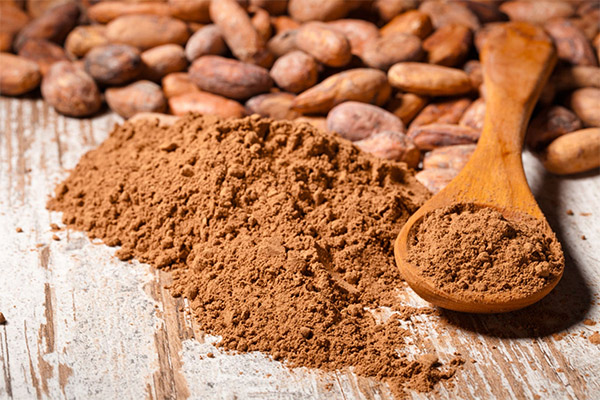
General benefits
- Cancer Prevention. Cancer is the second (by number of people) cause of death in the world. Free radicals, which are in the environment as well as in the food we eat, damage cells, resulting in dangerous mutations that sometimes lead to the development of tumors. But there are substances that can fight these free radicals and can reduce oxidative stress. Such substances are antioxidants. These powerful compounds are found in fruits and vegetables such as raspberries, blueberries, kale, and cocoa beans. By comparison, cocoa contains far more antioxidants than other foods rich in these substances (including green and black tea). Cocoa powder is particularly rich in polyphenols and flavonoids. These help the body protect cells from damage and from the effects of bacteria. Their range of abilities also includes slowing down and preventing the growth of cancer cells. Studies show a positive correlation between the consumption of cocoa products and cancer cell development. Cocoa powder helps slow the growth and multiplication of colon and prostate cancer cells without affecting the growth and function of healthy cells. But there is a downside. When the raw material is processed, especially when it is heated, the cocoa powder loses its antioxidant properties. This means that the powder in its pure form is more beneficial than products made from it.
- Reduced risk of heart disease. Cardiovascular disease is the most common cause of death in both men and women. In addition to helping the body fight free radicals and cancer, the polyphenols and flavanols in this product also have anti-inflammatory properties, so they help maintain a healthy heart. Flavonoids prevent blood clots and blood clots that block blood flow in blood vessels and arteries. And, since cocoa powder is a mixture of healthy monounsaturated and saturated fats, these fatty acids also help the body maintain normal cardiovascular health.
- Blood Pressure Reduction. Cocoa powder helps lower blood pressure. Studies show that those who consumed the largest amount of flavanol-rich cocoa powder were able to significantly lower their blood pressure in the short term. Another study showed that people who consume cocoa products daily have a higher circulation of nitric oxide in the blood. Because nitric oxide relaxes arteries and blood vessels, it helps to ease and increase blood flow. It is worth noting that the effects of lowering blood pressure were most significant with the consumption of cocoa products with high concentrations of flavonols. Therefore, dark chocolate is more beneficial than milk or white chocolate because it contains more flavonols.
- Normalization of cholesterol levels. Cocoa powder helps to increase the concentration of HDL cholesterol, which naturally helps to reduce the oxidation of LDL cholesterol. Therefore, consuming this product helps reduce cholesterol levels and is a preventive measure for heart disease.
- Reducing the risk of heart attack and stroke. Studies show that regular consumption of cocoa powder or cocoa-based products correlates with a lower likelihood of future cardiovascular complications.
- Reduced insulin resistance. The flavanols in cocoa are good for people with type 2 diabetes. They help improve blood sugar control and significantly increase insulin sensitivity while lowering fasting insulin levels. This is because the polyphenols in cocoa powder slow down digestion and absorption of carbohydrates and sugar. They also help break down glucose, allowing the body to allocate resources more efficiently.
- Maintaining brain activity. Regular consumption of cocoa powder can reduce or even prevent some signs of age-related cognitive decline. Polyphenols and flavonoids improve brain function, increase blood flow to the brain and prevent neurodegenerative diseases such as dementia and Alzheimer's disease. This is because flavonoids affect the production of neurons and the functioning of healthy brain cells. Catechin and epicatechin, two specific flavonoids, keep those areas of the brain responsible for memory and learning functioning normally. Catechins and epicatechins support brain cells and slow their death.
- Mood Enhancement. Cocoa and cocoa powder have properties that help a person feel happier, as consuming this product gives satisfaction, reduces symptoms of depression, and has an aphrodisiac-like effect. At times when one feels exhausted or tired, cocoa powder can help because it affects the production of neurotransmitters such as serotonin. The polyphenols in the powder not only improve mood, but also help reduce mental stress and remove chronic fatigue syndrome.
- Maintaining electrolyte balance. People on a diet very often neglect their electrolyte balance. If there is not enough sodium, magnesium, and potassium in the body, the person may experience headaches, fatigue and lethargy, arrhythmia, muscle cramps, nausea, diarrhea, or constipation. Cocoa helps replenish the need for magnesium (one tablespoon contains 6% of the recommended daily dose) and also saturates the body with other essential minerals.
- Maintaining healthy skin. The polyphenols and flavanols found in cocoa help your skin look healthier, as these amazing antioxidants improve circulation and blood flow, and increase oxygen levels in the body. All this contributes to a more even skin tone and a youthful appearance. In addition, these antioxidants also protect against the effects of ultraviolet light.
- Maintaining dental health. Because cocoa contains antioxidants that have antibacterial and immune-boosting properties, it can maintain healthy teeth and can also prevent gingivitis (inflammation of the gums). Theobromine, which is found in cocoa, protects tooth enamel and strengthens teeth. It is worth noting that this only applies to cocoa powder that does not contain sugar.
- Bronchial asthma prevention. Cocoa powder and cocoa-based products are helpful in treating bronchial complications. Alkaloids such as theophylline and xanthine present in cocoa powder help relax bronchial spasms. This improves breathing and helps the process of treating chronic allergies that lead to asthma.
- Healing power. Pharmaceutical companies use cocoa extracts in the production of medicines because of its wound-healing and therapeutic properties. Scientists view cocoa extract as an active agent that helps prevent the growth of infectious bacteria in the body. In addition, if taken with appropriate medical treatment, it can help eliminate Helicobacter pylori contagious bacteria from the body.
- Combat obesity. Regular consumption of cocoa normalizes lipid metabolism, and this helps reduce the synthesis of fatty acids.
- Treatment of constipation. People who suffer from chronic constipation can benefit from eating cacao-based products. Cocoa powder has therapeutic effects that help treat digestive and intestinal diseases. Several studies have been conducted to evaluate the product's effects on rectal, colon, and intestinal diseases. Research has shown that cocoa is a substance that enhances the functions that ensure the passage of food through the intestine.
- Protection against overheating. Cocoa trees are plants that are very well adapted to develop in very hot climates, and their fruits have similar properties. The beans contain melanin. It is able to neutralize the negative effects that the sun has. Therefore, the consumption of cocoa helps to avoid sunstroke, sunburn and overheating of the body.
- Muscle tissue repair. Cocoa powder that has not been thermally processed helps the body to regenerate muscle tissues after sports or physical exertion. Because of the high content of various useful substances, the product should be included in the diet of people with increased physical activity.
For women
Moderate but regular consumption of cocoa powder helps to strengthen capillaries, because it contains flavonoids. In addition, this product has properties that help the body accelerate the processes associated with wound healing, as well as contribute to the rejuvenation of the skin of the face.
Women who have hormonal imbalances are advised to consume cocoa drinks regularly. The substances contained in cocoa help balance the emotional state as well as help alleviate premenstrual syndrome.
For men.
Cocoa powder is a great preventative against heart attacks and strokes, as it has a positive effect on the heart muscle. If the blood vessels are in poor condition, it sometimes leads to impotence.
Cocoa powder also contains zinc, a substance that can increase libido. It is the main building material of testosterone and has a very positive effect on sperm quality as well as the sperm production process.
In pregnancy
Women who are pregnant should limit or avoid eating this product altogether. Cocoa powder can negatively affect the body of a pregnant woman, because it prevents the body from absorbing calcium normally, and this can significantly affect the growth and development of the child.
When breastfeeding
During this period, it is allowed to consume cocoa powder, but it is necessary to adhere to some rules:
- Introduce this product into a woman's diet only when the child is 1 month old.
- The first intake should occur before noon, this will help to track the reaction of the baby.
- Consumption can be started if the child is completely healthy.
- Drinking and eating products containing cocoa is recommended immediately after the end of feeding the baby, as this will significantly reduce the risk of allergies.
If there are no signs of allergies, it is allowed to eat cocoa a maximum of two times a week.
For children
As a rule, cocoa powder enters children's diet through drinks. In order to ensure that the use of this product will not bring harm to the child, you should adhere to some recommendations:
- Children from 2 years of age can be given up to 50 ml of cocoa per day (up to 2 times a week). No more than one teaspoon of cocoa powder should be added to the drink. It is recommended that it be consumed before dinner, but it should not be done right before a meal.
- After the child is 6 years old it is allowed to consume up to 100 ml of cocoa per day (no more than 3 times a week).
- Children over 10 years of age can drink the drink every other day.
Cocoa powder contains a high concentration of flavonoids, which are known to improve heart function and maintain oral health. It also helps protect the skin and improves its appearance. Do not use processed cocoa powder, which does not contain most of the flavonoids (the label should indicate 70% or more pure cocoa powder). The powder can also be added to milk or sprinkled on pancakes and waffles.
The benefits of cocoa powder for weight loss
Some women are wary of consuming cocoa products because they are afraid of gaining excess weight, but this is a big misconception. Cocoa powder itself has no negative impact on the figure, so diets based on it are very useful. But this is not always the case with chocolate, as one bar of this product contains a large amount of saturated fats, as opposed to the amount of these components contained in a mug of cocoa or in pure powder. Although cocoa is considered to be quite a caloric product, there is no need to worry that extra pounds will come with it.
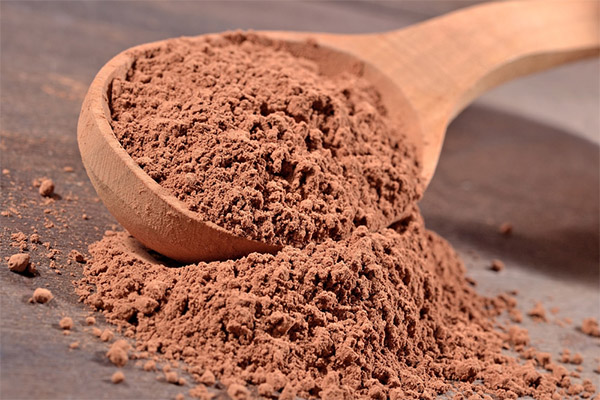
It should also be noted that the consumption of cocoa is very good for satiety. The powder can be added to protein mixtures - this will speed up weight loss, as well as to prepare ordinary drinks based on cocoa powder. It is important to remember that it is not recommended to drink more than 2 cups of cocoa per day.
The medicinal properties of cocoa powder
One of the main components of cocoa powder is caffeine and theobromine. Caffeine is a substance that has a tonic effect, theobromine improves blood circulation. The product contains fats, proteins, carbohydrates and minerals.
Cocoa contributes to the stimulation of processes related to brain function, and also the consumption of this drink helps to relieve stress and improves mood. The medicinal properties of the drink include its ability to prevent the development of diabetes, sclerosis, and dementia. It is also beneficial for hypertensive people. Cocoa contains polyphenols, which help control blood pressure.
Cocoa powder in cosmetology
Cocoa powder contains a large number of beneficial vitamins and minerals that have beneficial effects on the skin and hair. Vitamin A and B vitamins keep the skin youthful, giving it elasticity, slowing the appearance of wrinkles, as well as combating rashes and irritations. Potassium keeps the skin moist, while iron stimulates the oxygenation of the cells. Melanin helps to fight the effects of UV light.
Cocoa powder masks for the face
A mask for nourishing and moisturizing the skin:
- Dilute cocoa powder (1 tbsp.) in water until a smooth, thick mixture forms.
- Apply the mixture to the face for 10-12 minutes.
- Rinse off the mask with water.
Suitable for both oily and dry skin. For too dry skin, the water can be replaced with milk.
Mask for nourishing and moisturizing the skin
- Mix the raw egg yolk with 1 tbsp. heavy cream and add to it cocoa powder (1 tsp.).
- Grind thoroughly so that there are no lumps.
- Spread the mixture on the skin of the face and keep it until it dries.
- Wash off the mask with mineral water.
The composition nourishes, moisturizes and tightens the skin, as well as eliminates dryness.
Hair Masks
Hair strengthening mask:
- Mix one egg, cocoa powder (1 tsp.) and sour kefir (200 gr.) until a thick consistency.
- Apply the mask to the hair for 60 minutes.
- Wash the hair with water.
It is recommended to do the mask twice a week for 2 months. It will help hair to grow more actively and strengthen the hair follicles.
Hair Loss Mask
- Mix a small amount of hot milk with cocoa powder (1 tbsp.).
- After that, mix one beaten egg yolk with cognac (1 tbsp.) and add it all to the cocoa-milk mixture.
- We apply the resulting constitution on the hair and warm it.
- Wait for 30 minutes, then hair must be washed with water.
This mask helps people who are experiencing hair loss.
Cocoa powder in cooking
Cocoa is often used to make desserts and drinks. The powder can also be added to baked goods. It will be able to give the dish a characteristic flavor and also give it a nice chocolate touch. Cocoa powder is considered one of the most useful natural flavorings and colorings, which is why it is so actively used in children's food.
How to make chocolate from cocoa powder
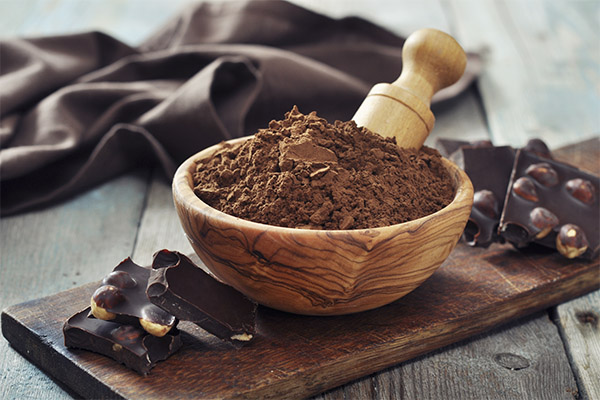
Ingredients:
- 100 g of cocoa powder;
- 1 tsp. sugar;
- 50g. butter (butter);
- 2 tbsp. milk.
How to cook:
- Heat milk over low heat.
- Add the cocoa powder and sugar to the milk.
- Melt the butter in a water bath.
- Mix the butter and milk.
- Bring mixture to a boil and leave on low heat for 2-3 minutes.
- Pour chocolate into molds.
- Chill in the fridge.
How to make cocoa powder with milk
Ingredients:
- 1 tbsp. cocoa powder;
- 0.5 l of milk;
- 1 tbsp. sugar.
How to cook:
- In a small saucepan, pour the milk and put on the fire (until boiling).
- Then add to the pot cocoa powder, sugar, and stir until the milk is dissolved.
- Leave it to boil for 5-6 minutes.
- Then remove the drink from the stove. Cover the pot with a lid and let the cacao infuse for a while.
How to make chocolate frosting from cocoa powder
Ingredients:
- 2 tbsp. cocoa powder;
- 3 tbsp. milk;
- 0.5 tbsp. powdered sugar;
- 30g. butter;
- 0.5 tsp. vanilla.
- In an enamel saucepan add the cocoa powder, sugar and stir. Then add the milk and stir well.
- Over a low heat, cook the mixture until it is foamy, stirring all the time.
- After that, remove the pot from the heat and let it stand for 10 minutes.
- Then add butter and beat with a mixer.
Chocolate cream for cocoa powder cake
Ingredients:
- 2 cups milk;
- 1 cup sugar;
- 4 tbsp. cocoa powder;
- 2 tbsp. flour;
- 150 gr. butter (buttery).
How to make:
- Mix cocoa powder with sugar and flour.
- While stirring the ingredients, gradually pour in the milk.
- While stirring, heat over medium heat until it comes to a boil.
- Allow to stand for 15 minutes, then add the butter and stir to combine.
- Allow the cream to cool.
How to Substitute for Cocoa Powder in Baking
Cocoa powder can be used instead of cocoa powder in baked goods:
- Carob. This is a powder obtained by processing the fruit of the carob tree. It is similar in appearance to cocoa powder, the only difference being that it has a less intense color. It also tastes very similar, but carob is slightly sweeter than cacao. Therefore, when using it, you can avoid adding sugar to a dish. There is no caffeine or theobromine in the powder.
- Chocolate. This is a confectionery product that is made from cocoa butter. High-quality varieties contain cocoa powder. Dark chocolates are a good substitute.
- Coffee (instant). Coffee is an excellent substitute for cocoa powder. Just 2 spoonfuls of instant coffee will suffice for baking. To neutralize the specific coffee flavor in baking, it is recommended to add flavorings.
Harms and contraindications
Cocoa powder contains some chemicals that affect the body similar to antidepressant drugs, so the use of this product can lead to some health problems - drowsiness, memory loss, confusion, difficulty breathing and apnea.
- For children. Excessive amounts of calcium in the body can be harmful to a child's health, as it can lead to bone deformities.
- For diabetes. Cocoa also raises blood sugar levels and can affect glucose control in people with diabetes.
- For sensitive people. The product can cause migraines in some people.
- Irritable bowel syndrome. Cocoa contains caffeine. In large quantities, it can aggravate diarrhea and IBS symptoms.
In the home of the cocoa bean, sanitary conditions are usually not very good. Therefore, products that contain cocoa can be harmful to the body.
It is also worth noting that cocoa beans are very fond of cockroaches, so after their presence in the product can remain chitin. Manufacturers use disinfectants and various aggressive chemicals that have harmful effects on human health.
How to choose and store cocoa powder
The first thing you should pay attention to is the aroma of the powder. By the smell you can immediately understand whether the product is fresh or not. The fragrance should be rich, with a bright chocolate hue, without any extraneous inclusions, and the color should be brown and chocolatey. If the product has too light a shade, it is likely to contain impurities, it is better not to buy such a powder. Even, fine grinding indicates its quality. When you grind it, the powder should not have any lumps. Its fat content should be 14-17 percent.
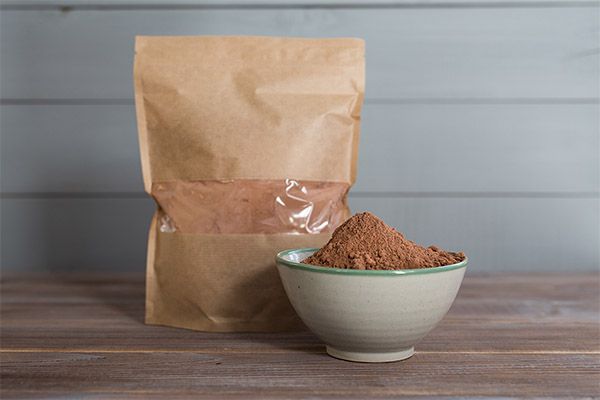
Natural cocoa powder that is meant to be brewed can be stored for no more than 6 months. If we are talking about instant powder, its shelf life is longer due to preservatives. It can be stored for up to 2 years (in a metal container). It is recommended to store the powder in a dark ventilated place with humidity of no more than 75% and a temperature of +18°C (plus or minus 3 degrees).
How often you can drink cocoa
Even though cocoa is a very healthy drink, it is not recommended to drink more than 2 cups per day. This drink will be especially good for people who are engaged in mental activities or have regular physical activity. The best time to drink cocoa is in the morning. You should not drink this drink in the evening, otherwise insomnia may occur.
Interesting facts about cocoa
- It takes about 900 beans to make a kilogram of chocolate.
- December 13 is National Cocoa Day.
- Cocoa was banned in Europe. There was a period when the Catholic Church forbade its consumption, otherwise one was declared a heretic. It was believed that this product polluted the blood and could change the color of children's skin.
- The ancient tribes of the Maya were the first to discover the amazing charming properties of cocoa beans. That was around 600 A.D.
- In 1502, Christopher Columbus is believed to have brought cocoa beans to King Ferdinand as he returned from his voyage to the New World.
- Cocoa has been exported to Europe since 1585, but the first bar of chocolate was not produced until 1848.
- Worldwide, the annual production of cocoa amounts to 3 million tons.
- The time it takes for the cacao tree to produce its first beans is five years.
- During the heyday of the Aztec civilization, cocoa beans were used as currency.
- More than 70% of all cocoa in the world is produced in West Africa.
- Cocoa plants must be planted near tall trees to protect them from direct sunlight.
- The composition of the soil on which the trees grow affects the taste of the cocoa bean.
- Machines are not used in the production of this commodity, each step (planting, watering, harvesting, fermentation and drying) is done by hand.
- Amsterdam is the largest port of cocoa in the world, with more than 500,000 tons of the product passing through every day.
- One of the last Aztec emperors could drink about 50 bowls of cocoa drink a day.
«Important: All information on this site is provided for informational purposes only. for informational purposes only. Please consult a health care professional before using any of our recommendations. health care professional before using any of the recommendations. Neither the editors nor the authors shall be liable for any possible harm caused by materials."


